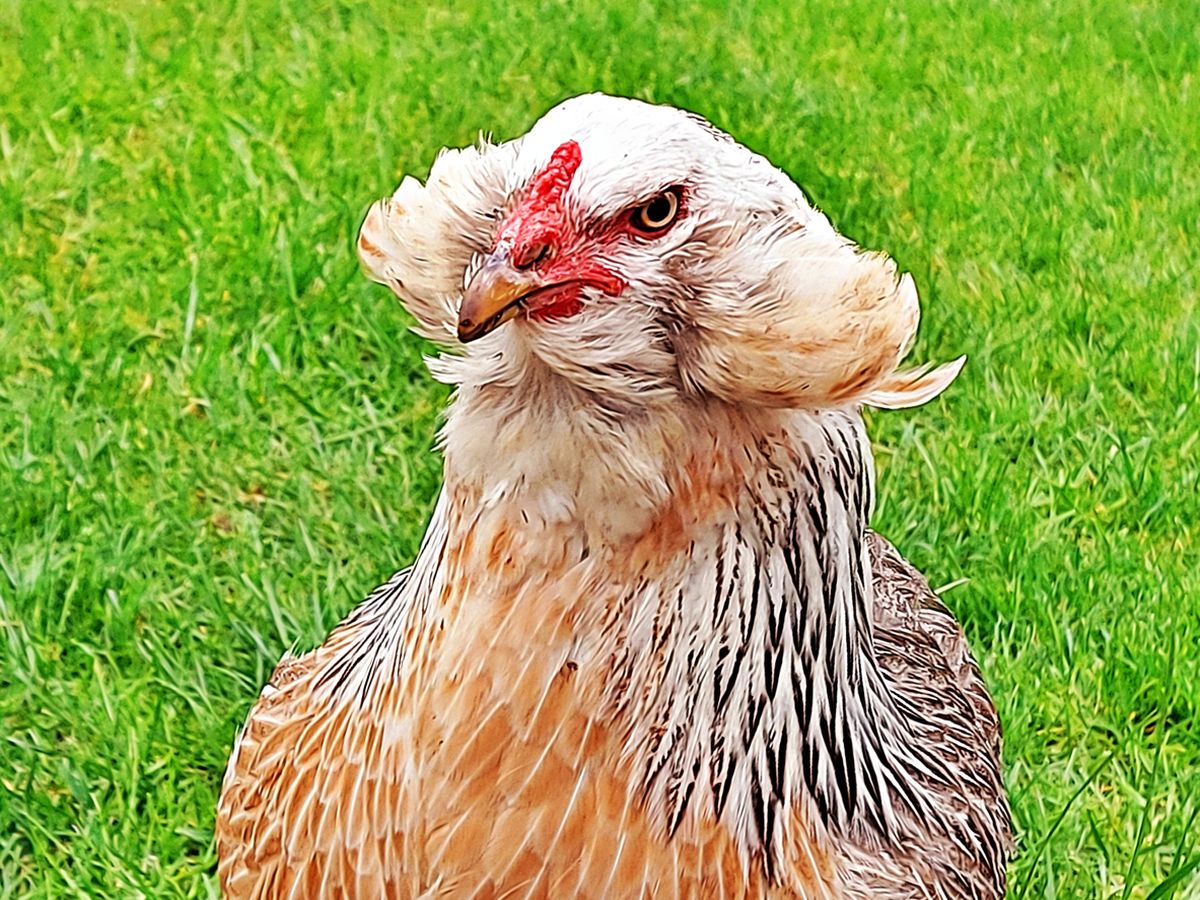Araucana chickens have a unique appearance, but their care requirements are standard. So, if you’re looking to care for some birds that stand out in your flock, consider this special breed.
Araucana Chicken Overview
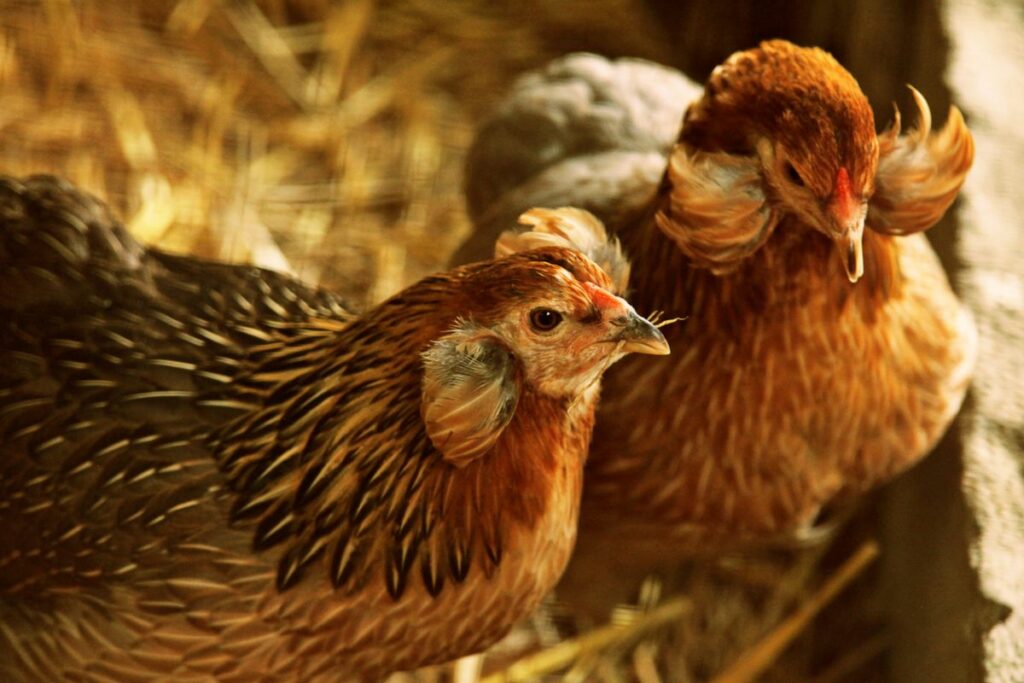
Before we dive into the details of this chicken breed, here are some of the general characteristics to be aware of.
| Lifespan | 5 to 10 years |
| Weight | 5 to 7 pounds |
| Appearance | Solid black, white, or brown feathers. Sometimes they have tufts on the sides of their heads. |
| Egg Production | 3 per week |
| Egg Color | Blue/Green |
| Good for Beginners? | Yes |
| Minimum Coop Size | 4 square feet per bird |
| Price | $20 to $35 per chick |
Araucana History
The exact history of this chicken isn’t known for certain. However, the most well-known theory suggests that they originated in Chile. A man known as Dr Bustos had been experimenting with breeding chickens to create the Araucana.
It’s suspected that this breed is a combination of Collonca and Questros chickens of Chile. Most sources state that the breed was first created in 1918. Yet, another version of their history suggests that Micronesian Islanders brought them across the Pacific Ocean. So, the exact origin is unknown.
Araucana vs Ameraucana
Sometimes this breed is mistaken for the Ameraucana, or even for an Easter Egger, which is a mix of the two. Yet, this chicken breed has some distinct differences from both of the other breeds.
Araucanas and Ameraucanas both lay beautiful blue eggs. Yet, their external appearances are slightly different. Ameraucanas have muffs and beards while Araucanas have neither but sometimes have ear tufts instead. However, with improper breeding, those ear tufts could be deadly.
Araucanas are also “rumpless,” meaning they have no tail. Ameraucanas have a distinguished tail.
Easter Eggers have a wider color variety when it comes to feathers and eggs. While both the parent breeds lay blue eggs, Easter Eggers lay a wide range of colored eggs, which is why “Easter” is in their name.
Araucana Appearance

Now that we’ve distinguished the main differences between this breed and similar ones, let’s look at the specific characteristics. Here’s what Araucanas will look like during every life stage.
Araucana Egg Color
Araucana eggs are usually blue like a robin’s egg or light green. The eggs are considered medium-sized.
Chick/Pullet Appearance
These chicks look similar to your typical chick, thanks to their fuzzy black and yellow feathers. Yet, from birth, these birds are rumpless like their parents. If they end up having ear tufts, those will start to be visible as chicks.
As chicks age, they grow in their adult feathers, allowing them to look like small versions of the adults. In their pullet stage, their ear tufts will become much more pronounced if they have them.
Adult Appearance
Most adult Araucanas are a solid brown, white, or black color. However, their ear tufts are what distinguishes them from other birds. Some Araucanas have feather clumps that stick out on each side of their heads.
They’re also “rumpless,” so they have no tail. This causes them to have a very tall posture. They have a red pea comb on their head.
Unfortunately, the gene that causes the ear tufts increases the risk of death in chicks. So, reputable breeders avoid breeding two chickens with ear tufts together to ensure that the chicks stay healthy.
Size and Weight
This breed is considered standard size. An Araucana hen typically weighs about 5.5 pounds while roosters are close to 6.5 pounds.
Araucana Temperament
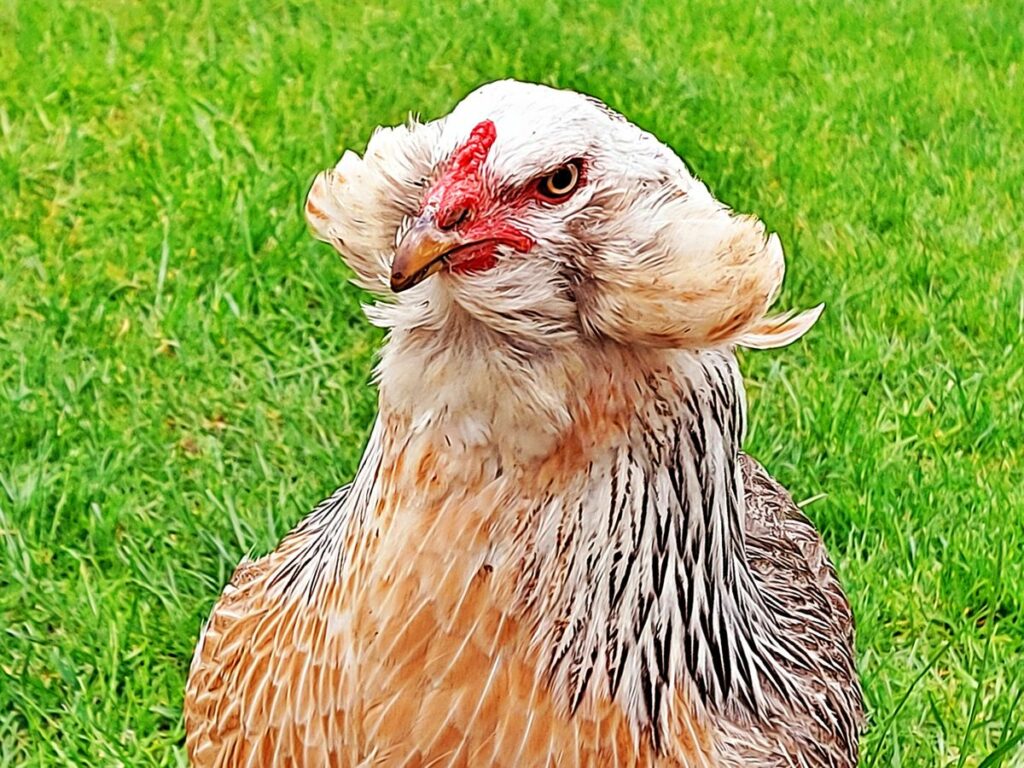
There’s a lot of dispute about this breed’s temperament. Most chickens are friendly, docile, and love to be handled. They’re even well-behaved around children. However, there’s always a chance they could be more hesitant. It depends on their DNA and how they’re raised.
Keepers who work hard to raise the breed in a loving environment usually find success in raising friendly birds. So, they can make good beginner birds for a determined keeper.
Broodiness
One difficulty with raising Araucanas is that they tend to go broody. They love raising chicks and protecting them when necessary. Instead of trying to interfere with their broodiness, it’s best to let them hatch and care for the chicks themselves.
Yet, you’ll still need to keep an eye on the eggs. Sadly, this breed has a low hatch rate, so if the hen has been broody for longer than usual, you may need to remove the eggs if they’re dead. Hens who brood for too long may lose weight and look rough.
Noise Levels
For the most part, these chickens are quiet. They make normal chicken sounds, such as egg songs and chatter in the coop, but it likely won’t be enough to bother your neighbors.
Do They Get Along with Other Animals?
This breed does best when kept only with its own breed, but they can still be fine around other birds. Due to their friendly nature, they’re not bothered by other animals unless they feel threatened.
Araucana Care Requirements
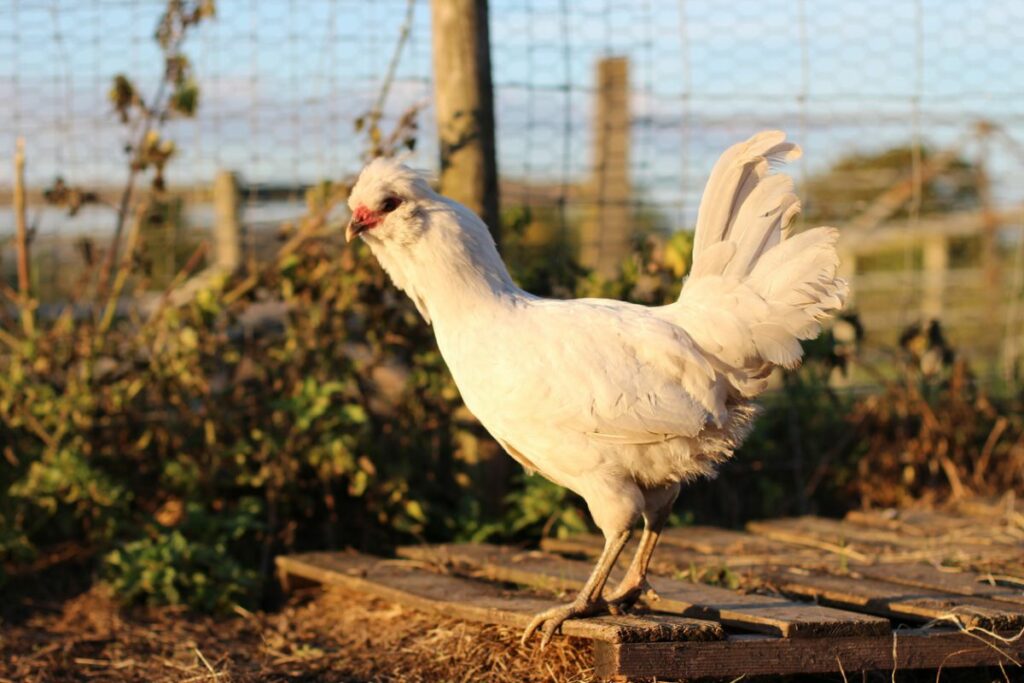
You might be drawn to the Araucana’s appearance, but you should never buy an animal just based on looks. Here are some basic care requirements for the breed so you can decide if they’re the right chicken for you.
Feeding
All chickens need a balanced feed to thrive. As chicks, this breed needs a starter feed that’s high in protein. Around 20% protein is ideal.
Once your chicks get to 18 weeks old, you can transition them to an adult feed with about 16% protein. Full-grown hens should also be fed oyster shells in a separate container for added calcium. Without it, the blue Araucana eggs won’t be as healthy.
Araucanas love to roam, so they can get a lot of their nutrients from foraging. If you give them free-range time, they will pick up bugs and weeds, which will clean your property and give them nutrients at the same time. Foraging is in addition to chicken feed, not in the place of.
Enclosure
These chickens are on the small side, but they still need at least four square feet of coop space each. For their outdoor run, they should have at least eight square feet per chicken, but more is always better. Giving them free-range time or a large enclosure is the best way to keep them healthy and content.
If these chickens feel crowded, they’re likely to show aggressive behaviors, especially when it’s cold. So, give them more space than they need to prevent them from hurting each other. They like to have enough space to spread their wings.
Full-grown Araucanas might have a greater desire to fly than the average chicken. So, provide them with lots of perches of varying heights to satisfy those needs. They should also have one nesting box for every three hens. They need a standard size of 12 inches by 12 inches.
Temperature
This breed is great for all weather conditions. Araucanas originated in warm areas, but today, they’re hardy birds that can thrive in cold climates too. However, their pea combs are prone to frostbite, so you may need to get a coop heater for extreme winter conditions.
Health Concerns
Adult Araucanas are generally healthy birds. However, the chicks face lots of concerns. If two chickens with ear tufts are bred together, then the mortality rate of the chicks will be high. Almost all chicks will die if both parents have it.
Even if only one parent has the ear tuft gene, the chicks will have a 20% mortality rate. So, even though the tufts look cool, your birds will be safer if you avoid it. Luckily, the chicks that do survive are usually healthy and grow quickly.
Araucana Egg Production
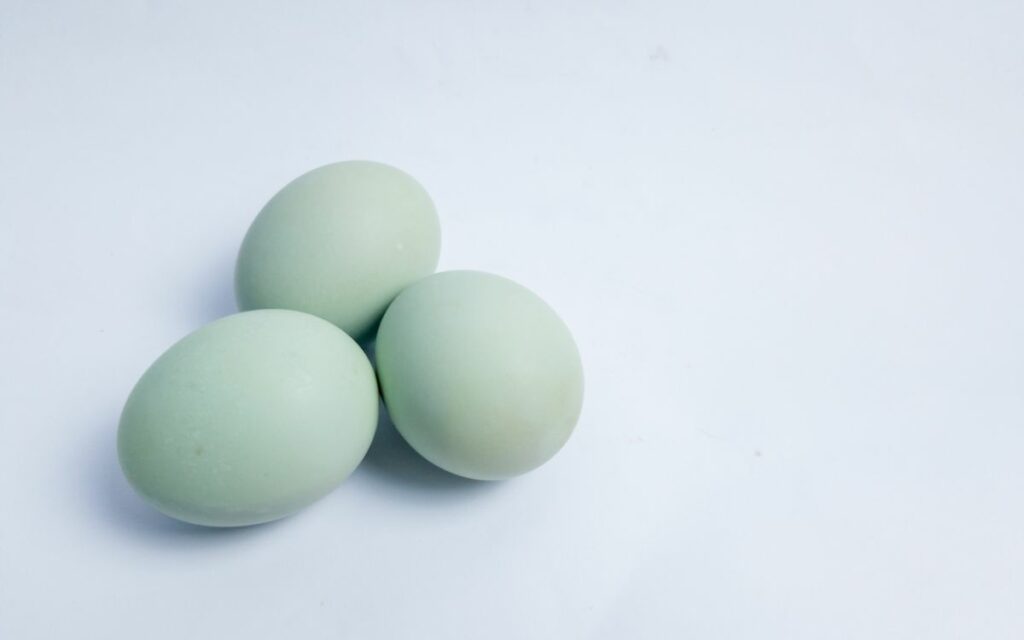
Araucanas are more common for meat and pets rather than egg production. They only produce about three eggs per week. Your family can still enjoy the eggs, but your hens probably won’t produce enough to sell.
Frequently Asked Questions
Before you decide if an Araucana chicken is right for you, there might be some lingering questions in your head. Here are few things that new chicken keepers often ask.
Are Araucana Chickens Rare?
Yes, many people consider this breed rare. They’re hard to come by in the United States, which is why chicks might be more expensive than similar breeds. One of the reasons they’re hard to find is that many breeders avoid breeding them due to their low hatch rate.
Do Araucana Chickens Fly?
Yes, like most chickens, Araucanas can fly. Yet, they usually only fly short distances to get onto perches or escape danger. It’s unlikely that they’ll fly away from a fenced-in enclosure.
Where Can I Find Araucana Chickens for Sale Near Me?
You might have a hard time finding this breed for sale in your area since they’re not common. Ask chicken breeders and keepers if they know of any Araucana breeders near you. When choosing a breeder, make sure you buy from someone who’s knowledgeable about the breed rather than someone who’s in it for the money.
Is This Chicken Breed Right for You?
If you’re able to find Araucanas for sale, they could be great chickens to care for. They’re friendly and docile, making them easy for beginners. If you’re just looking to dip your toe in the chicken keeper world, they might be a great choice.
However, if you’re looking to sell eggs or breed your birds, then these chickens probably won’t be the best choice. They only produce a moderate amount of eggs, and many chicks die if you breed them. So, consider those aspects before taking some of these unique chickens into your care.
